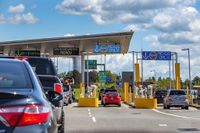Shirley Cuschieri used to visit the United States twice a year, but now, as she plans her next getaways, the allure south of the border has faded. Instead of her annual shopping trip to Las Vegas with friends, the Saskatoon resident opted for a spa retreat in the Rocky Mountains of Banff and Canmore, Alberta. "We just realized that it didn’t matter where we were, so much as none of us could stomach the idea of supporting U.S. tourism," Cuschieri told the Regina Leader-Post. Her decision, she explained, goes beyond the ongoing Canada-U.S. trade tensions. Concerns about democracy and human rights in the U.S. weigh heavily on her mind. "I’m feeling that if I never get to go to the United States again, I think I’ll be fine. There’s too many other things that I want to do, and too many other places that I want to go in this world. I could live without it now. The longer people go without doing things in the United States, I think the longer it becomes easier."
Cuschieri’s stance isn’t unique. According to Statistics Canada, 23 percent fewer Canadians returned home from U.S. visits in the first half of 2025 compared to the same period last year. The trend isn’t one-sided either: Americans visiting Canada dipped by 3.8 percent. Despite this, some pockets show a different story. Regina International Airport, for instance, reported a 48 percent jump in passengers taking direct flights to the U.S. during the first seven months of 2025 compared to 2024. Airport officials credit new daily flights to Denver by United Airlines and a recently added Minneapolis route by WestJet for the surge. The airport’s U.S.-bound flights have been running at a healthy 70 to 80 percent capacity each month, a spokesperson noted, calling it "great to see."
What’s driving this shift in travel patterns? Wayne Smith, director of the Institute for Hospitality and Tourism Research at Toronto Metropolitan University, sees a blend of factors at play. "When people don’t feel safe, for whatever reason, they tend to stay closer to home," Smith told the Leader-Post. "Add in a feeling of patriotism and the sort of nationalistic feeling that’s going on, and then the willingness to support local businesses, put that all together (and) it’s actually a pretty good mix for the Canadian tourism industry."
The Conference Board of Canada estimated in May that if Canadians continue to pivot away from U.S. travel, domestic tourism spending could balloon by $8.8 billion. That’s not just a number on paper—it’s a windfall for resorts, hotels, and small businesses across the country. At the Manitou Springs Resort and Mineral Spa, about 120 kilometers southeast of Saskatoon, assistant general manager Carrie Schaan has noticed the uptick. The hotel has been maintaining an estimated 70 percent occupancy rate on weekdays and is nearly fully booked on weekends. "Almost all year round we’re booked up on weekends and that is the norm," Schaan said. "Our weekdays are usually not quite as busy (whereas) this year we have been extremely busy …"
The camping scene in Saskatchewan tells a similar story. Despite persistent wildfires and smoky conditions affecting some northern parks, the province’s Ministry of Parks, Culture and Sport reported that camping numbers have remained consistent for the 2025 summer season. In Regina, the city’s tourism department highlighted a notable boost in visitor activity: arrivals are up 9.6 percent and hotel occupancy has climbed by four percent compared to the first half of 2024. "These indicators point to a strong, positive tourism outlook for Regina in 2025 and reinforce the value of choosing Canadian destinations for summer travel," the city said in a statement.
Yet, the story isn’t one of a closed border or a total reversal. Even as some Canadians, like Cuschieri, reconsider their travel plans, American tourists are still crossing the border to explore Canada’s charms. Nowhere is this more evident than in Niagara-on-the-Lake, where U.S. visitors from Boston, Milwaukee, San Francisco, Annapolis, Pittsburgh, Memphis, Atlanta, Naples, Detroit, and Los Angeles flocked in August 2025, according to Niagara Now.
Take Archie Reyes from Boston. He drove to Niagara-on-the-Lake after an Air Canada strike canceled his flight, helping friends settle into Toronto and visiting family in Mississauga. "We always go to the Prince of Wales hotel because it’s a signature part of the town to take photos with," Reyes said. For him and his group, the trip is a regular tradition, complete with vineyard drives and sightseeing at Niagara Falls.
The Stewart family from Milwaukee made a two-day drive, stopping in Michigan before arriving in Niagara. "We came a long way to see the falls, so we stopped in Michigan at the halfway point," Doug Stewart said. Their detour to Niagara-on-the-Lake was a spontaneous decision, but one they relished. The Brodericks from Boston echoed that sentiment, noting the town’s "quaint" feel and memorable treats from the Budapest Bake Shop, though they admitted the location was "so out of the way from Boston."
Not all visits were by car. Dave and Shelli Kravitz from San Francisco flew five hours to join a group tour. "We’re actually not spending the night here (in NOTL), which I’m so bummed about. This is incredible, it’s so beautiful," Shelli said. Her husband Dave was equally taken: "It’s beautiful. I like all the shops and galleries and so on, and all the flowers."
For some, the journey was about more than sightseeing. Dawn and Eric Luedtke from Annapolis, Maryland, celebrated their fifth anniversary in the region, taking in performances at the Shaw Theatre Festival. "It’s a beautiful town. We live in Maryland, which has a similar sort of older feel. Historic," Eric said. The Villarreals from Pittsburgh and the Broths from Atlanta both cited recommendations and previous visits as reasons for returning, with the Broths calling Canada "our little brother" and marveling at the region’s wineries and cleanliness.
Other visitors, like the Beteta sisters from Los Angeles, found their way to Niagara-on-the-Lake thanks to social media buzz and a desire to see Niagara Falls from the Canadian side. "I just really like the architecture, I think it’s a very cohesive look altogether and it’s giving a lot of small-town vibes," Shirley Beteta said. The Roths from Detroit, in Ontario for Riverfest Elora, tacked on a visit to Niagara to experience the local theatre and culinary scene.
Despite the recent challenges—trade tensions, fluctuating travel patterns, and even an Air Canada strike—cross-border tourism between Canada and the U.S. remains resilient, if a little transformed. While some Canadians are choosing to explore their own backyard, Americans continue to find reasons to visit, drawn by Canada’s festivals, historic towns, and natural wonders. The numbers may ebb and flow, but the stories of travelers on both sides of the border show that curiosity and connection still drive the journey.


